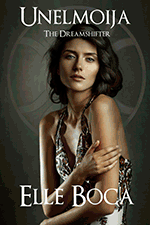by Editor | Dec 15, 2014 | Food and Wine, Restaurants and Food
By Elena del Valle
Photos by Gary Cox

The exterior of Lolita Vinoteca + Asador
Lolita Vinoteca + Asador (90 Congress Street, Portland, Maine 04101, +1 207-775-5652, http://www.lolita-portland.com/, info@lolita-portland.com), a few blocks past the Portland Observatory on one of Portland’s main streets, was easy to find. Maine’s coastal city had many dining choices from exotic to exclusively local. Lolita, established by Guy (executive chef) and Stella Hernandez and Neil Reiter was the only Spanish themed tapas eatery with a wood fired oven we came across. The 900 square foot eatery with a staff of 12, table seating for 20, and space for 10 at the bar opened its doors in June 2014.

Guy and Stella Hernandez
The menu, described as “American cuisine, guided by Mediterranean and old-world traditions,” featured small plates and plates to share with specialty dishes from the wood-fired grill and meats from the eatery’s antique prosciutto slicer.

Bread, honey and Consider Bardwell cheese
Prior to Lolita, Guy and Stella owned and operated Bar Lola for seven years. Lolita is a reference to that previous establishment in that the Asador where we had lunch was smaller and less structured than Bar Lola had been. Vinoteca, or wine facility in Spanish, referred to Stella’s wine and beverage background. There was a list of 75 wines featuring classic wine regions and varietals, as well as unique selections from around the world. Plans were in place for an extensive by-the-glass program with full, half-glass and flights options. Asador, referring to an establishment that features food cooked over an open fire in Spanish, highlighted the custom grill in the open kitchen.
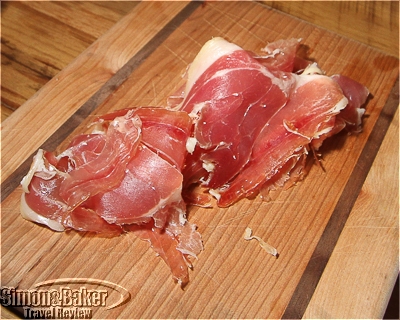
A serving of thinly sliced Serrano ham
Before entering the restaurant industry, Guy held a number of teaching positions in architectural design and technical drawing. In 2006, before opening Bar Lola, Guy was a baker at the One Fifty Ate Bakeshop in South Portland, and assisted with the launch of Scratch Baking.
Stella, general manager and beverage director at Lolita, had more than a decade of experience in the hospitality industry. Prior to working at Lolita, she held the same positions for Bar Lola. She was a member of the Guild of Sommeliers and was taking Court of Master Sommeliers education courses. Stella and Guy were the owners of Hilltop Coffee, nearby.

The Sardine Rillette pot with bread
Neil’s passion for the restaurant industry grew out of his experience as a silent partner in several successful New York City restaurants and clubs. Previous entrepreneurial experiences included founding and being president of Reiter Marketing Group, Inc., and R & J Partners, LLC.

Our order of Wood Roasted Clams
We liked the casual contemporary decor with post industrial features, as well as the friendly and well informed, if slow paced, service. Mostly we enjoyed the food. We sampled a variety of the dishes: Thinly sliced Serrano ham from La Alberca, Spain; the day’s special short rib panino; Consider Bardwell, a West Pawlet, Vermont cheese; local Wood Roasted Clams (a favorite); Spicy Sardine Rillette, served in a pot with roasted slices of bread; Grilled Romaine served with Tarragon Vinaigrette and Pecorino cheese shavings (a favorite); and a homemade Apple Tarte Fine for two. We washed it down with a glass of cava and a pale ale.

The Grilled Romaine

One of the staff making Grilled Romaine in the Asador
Our only complaint? Parking was difficult to find in the residential neighborhood of Munjoy Hill. It took us ten or more minutes of circling around the eatery to locate a parking space two blocks away where we hoped our car would be safe from the tow trucks announced on many city signs.
by Editor | Sep 8, 2014 | Attractions, Food and Wine, Luxury Travel
Article and photos by Josette King

The rear of Monticello overlooked vast expanses of lawns and flower borders
This was my first visit to Charlottesville, Virginia, a small historic city with a big reputation. I admit I approached it with a degree of skepticism. Everyone I knew who had ever visited had come back smitten and daydreaming about settling there. Surely, no place could be that idyllic? Charlottesville was.

Montpelier offered stunning views of the Blue Ridge Mountains
Although a mere 115 miles (185 kilometers) from Washington, D.C. and 70 miles (110 kilometers) from Richmond, this small Central Virginia city nestled in the picturesque rural foothills of the Blue Ridge Mountains had, in spite of its popularity, retained the charm and tranquil pace of earlier times. Its once Main Street was now the Downtown Mall, an eight block tree shaded pedestrian walkway lined with restored historic buildings. There, antique shops, art galleries and all manner of fashion boutiques mingled with café terraces, restaurants, pubs and several movie and live performance theaters. A favorite spot for tourists as well as local people had a Freedom of Expression Wall where passersby could pen (in chalk) what was on their mind, which I was told included the occasional marriage proposal. The wall was erased each night to give others an opportunity to have their say.

Passersby were welcome to scroll their thoughts on the Freedom of Expression Wall
Charlottesville has conserved to this day the enduring mark imparted upon it two centuries ago by its most illustrious citizen, Thomas Jefferson. In addition to his Monticello home, he founded and designed the University of Virginia. Both of the neoclassical (or Jeffersonian style) masterpieces are now UNESCO World Heritage Sites. Today, Monticello attracts half a million visitors annually and the University of Virginia, with its yearly enrollment of over 23,000 students, contributes significantly to the cultural vitality of the area.
Jefferson also made a significant impact on the landscape of the area, albeit posthumously, when he attempted to establish vineyards on land adjoining Monticello, only to have his efforts thwarted by the start of the Revolutionary War in 1774. In the latter part of the 20 century, a handful of determined growers were inspired to revisit his vision to develop the Central Virginia vineyards.

The tasting room at Jefferson Vineyards Winery
Today, Virginia has over 2,000 acres (810 hectares) of vineyards, half of them around Charlottesville. Almost 30 of the wineries form the Monticello Wine Trail and welcome visitors in their tasting rooms. A well mapped itinerary took me along some of the loveliest back roads of the greater Charlottesville area. One of the oldest, Jefferson Vineyards, was within a stone’s throw of Monticello, on the very land where Jefferson made his own wine growing attempt.
In addition to Thomas Jefferson, the Charlottesville area was also home to two more of America’s Founding Fathers, James Monroe and James Madison. All three became President of the United States and their respective homes Monticello, Ash Lawn Highland and Montpelier were open to tourists. I combined their visit, in an itinerary known as the Presidents Trail, with that of nearby wineries. Along the way, I soon discovered that the bucolic setting had drawn a large number of talented artists and craftspeople, whose studios and galleries made for an enjoyable visit as well.

Glass artist Cara DiMassimo with some of her recent creations
With its charming rural environment, rich history, vibrant artistic life, inviting vintage downtown, wineries and more than a few notable restaurants to boot, I could see how Charlottesville could be an enjoyable place to live. It was an exceptional place to visit.
by Editor | Apr 28, 2014 | Food and Wine, Restaurants and Food
By Elena del Valle
Photos by Gary Cox

Bellota Bellota in the Latin Quarter (click photo to enlarge)
On a recent trip to Paris, France we ventured to Bellota-Bellota, a new gourmet shop with on site dining in the Latin Quarter (Bellota-Bellota Saint Germain, 64 rue de Seine, 75006 Paris, France, +33 1 46 33 49 54, www.bellota-bellota.com, aszabo@bellota-bellota.com). From the sidewalk we could see through a large display window. The distinctive azulejo tiles and hanging hams in the decor were a sign of the treasure trove of domestic and imported goodies housed inside. When we first arrived in between meal times we had the dining area and shop mostly to ourselves. Despite the touristy location there was a steady trickle of French customers picking up supplies to go. Such was the case with two gorgeous poodles who were as fond of the shop’s famed dry aged distinctive hams imported from Spain as their owner.

Watching the Bellota slicing is part of the fun
We relied on the staff’s knowledge and advice in our extended late afternoon tasting. We started with the shop’s seafood products. First, there were three varies of Tarama (a creamy spread made with roe), natural, lobster and truffle. We were lucky to be able to sample them all. The server explained they didn’t always carry the lobster Tarama. The wild Alaska salmon eggs were non pasteurized (though previously frozen). The sliced-by-hand Norwegian salmon, farm raised in an area with many currents, was memorable. Double smoked in Germany with elderwood it had a rich, well rounded flavor without greasiness.

The three varieties of Tarama we tasted

Wild Alaskan salmon eggs
Spanish pork products were next. Gijuelo, a 58-month chorizo, Fayet from Catalonia (from a Celtic pig), lomito (pork loin from the end of the filet), and lomo, pork loin aged 20 months and vacuum packed, were next. The Fayet, somewhat hard and aged, was flavorful. Although we enjoyed all of them the lomo was our favorite. They were served with a homemade tomato blend of French tomatoes, garlic, olive oil, and salt flavored with rosemary, thyme, basil and laurel.

Two different cuts of the Norwegian Salmon

A selection of Spanish pork products with crackers and homemade tomato dip
A volcano shaped dish designed by Bernardeau on Limoges porcelain was born from an idea by Phillipe Poulachon, the Bellota-Bellota founder. The plate had space in the middle for a votive candle to gently warm the fragrant bellota ham in order to enhance the flavor. The warmth of the candle, a staff member explained, should make the fat of the ham translucent at 28 Celsius, the ideal temperature, and display the product to its best advantage. We sampled pata negra Grand Crus from the Guijuelo region of Spain and Bellota-Bellota from Huelva and Jabugo. The small portions disappeared as if by magic from the table. It was served with crystal bread without leavening.

The special volcano shaped serving plate (click photo to enlarge)

A different cut of meat on the volcano (click photo to enlarge)
The bellota hams were selected from among the best produced in Spain, the shop specialist explained. The company trained its staff to identify ideal hams by using a horse bone, known as a cala, to pierce the seven veins in a pork leg. He demonstrated the process on one of the ham legs in the shop, inviting us to note the variations in the different hearty vein smells. Thirty percent of the original weight of the pork meat is lost to the dry aging process, he went on to explain. Some studies in Spain, he mentioned, suggest the oleic acid in the pork may be good for heart health.

The staff demonstrated piercing the ham to check the curing process

The scents of the ham from different testing points were intense
We also sampled delicious Pluma de Pata Negra rare grilled steaks with a heavenly scent prepared at the shop. They were made from frozen as only 600 grams of pluma were produced from each Iberico de Bellota ham, the staff person told us. They were tender and oh so flavor filled. They were served with Pimientos de Padron green peppers (also from frozen), and mashed potatoes with olive oil.

Pluma de Pata Negra rare grilled steaks
Sharp cheeses from Spain, that matched the powerful deli meats, closed the savory portion of our tasting menu. There were two types of manchego and a torta d’Extremadura from Salamanca. The strong Extremadura cheese, made with raw ewe’s milk, was aged 60 days and turned by hand daily. The cheeses were served with quince jam.

Manchego cheese with quince jam
The staff selected Spanish wines to match our tasting: Pago Vallegarcia made from 100 percent vignior from Toledo, and a red Bassus Premium, a spicy blend of bobal, cabernet sauvignon, shiraz and petit verdot grapes from Utiel Requera from Valencia; a red 2007 Coma Vella (priorato) made with grenach, cabernet sauvignon, carinera, syrach from south of Barcelona. To complete our tasting, we had Spanish turrones (nougat) from Alicante and Girona followed by French Madeleine pastries made with honey harvested by handicapped artisanal makers from Les Cevennes, France.

A selection of Spanish wines and champagne was available
From beginning to end the tasting was a delight. The cheeses, salmon, Tarama, and salmon eggs were free of preservatives. Our favorites were in no particular order the double smoked salmon back, the 20-month aged lomo and the aged Bellota-Bellota Grand Cru hams.
by Editor | Jun 3, 2013 | Food and Wine, New Articles
Article and photos by Josette King
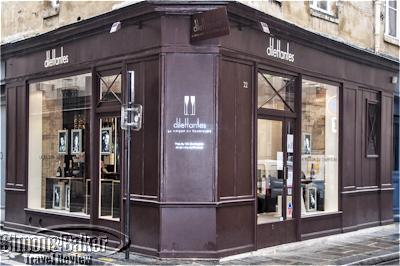
Dilettantes welcomed customers to its elegant corner store front
A far as I can remember, Champagne was synonymous with celebration in my family. From an early age, I understood how exceptional it was: served only on special occasions, in its very own glasses from my mother’s best crystal. And it could only come from the famous region a couple of hours east of Paris that gave it its name. Everything else in thick dark glass bottles with wired corks was just mousseux (bubbly), a word best spoken with a hint of condescendence.

The map of Champagne is a mosaic of small vineyards
Later on, I discovered various major labels of Champagne, and even learned to tell the difference between their offerings. And in my travels around the world, I had many opportunities to experience local sparkling wines that ran the gamut from very nice to best avoided. So I had come to consider myself somewhat knowledgeable about Champagne; until I walked into Dilettantes (22, rue de Savoie, 75006 Paris, France, + 33 (0)1 70 69 98 68, www.dilettantes.fr, champagne@dilettantes.fr), a unique new cave (wine cellar) in the heart of Paris’ historic Left Bank, dedicated exclusively to Champagne.

Fanny Heucq introduced me to the various shapes of Champagne flutes for optimal tasting
Located on a side street of the tony 6th Arrondissement, a stone’s throw away from the Seine and the Ile de la Cité, Dilettantes is the brainchild of Fanny Heucq. Born in a family of Champagne vignerons (growers and producers) Fanny knows first hand of the wide variety of high quality Champagnes that are produced in small quantities by artisan growers and rarely available beyond their region of origin. Her goal was to take her Parisian customers past the familiar Grandes Maisons (major world-famous brands) and introduce them to these “other” Champagnes, as diverse as the vineyards and growers that produce them.

All available labels from the various artisan growers were displayed in the cellar
“I wanted to get beyond the labels to focus on the rich diversity of the crus (vineyards) and the passion of the people who work them,” she explained, nodding at the large black and white photographs that line the windows of her elegant shop. They are the weathered faces and the calloused hands of the vignerons that work the various crus showcased at Dilettantes.

Each bottle was sold with its own identification card
Fanny pointed to a map of the official growing region of Champagne, a mosaic of small vineyards scattered around a 31,598 hectare (122 square mile) area, itself divided into four terroirs (growing areas). “Depending on the soil and the altitude, a different variety of grapes will thrive,” she explained. “In the Montagne de Rheims, it’s 60 percent pinot noir and 40 percent Chardonnay. But to the west, the Vallée de la Marne is just about all pinot noir with barely 10 percent pinot meunier, while a bit to the south, la Côte des Blancs is almost exclusively Chardonnay, and down here,” she pointed due south, “La Côte des Bars is exclusively pinot noir. But the soil is harder here, the microclimates different than around Rheims, so the grapes have a different personality.” Dilettantes featured 25 artisan producers representing the four terroirs, plus a limited selection from a handful of the Grandes Maisons. I was just beginning to grasp the extent of what I never knew I didn’t know about Champagne.

A selection from a handful of world-famous brands was also available
Why Dilettantes? I asked. “Originally, a dilettante meant a passionate amateur, a connoisseur” Fanny pointed out. “Our aim was to create an environment where our customers can discover and appreciate the uniqueness of each cru.” There were many ways to “discover and appreciate” at Dilettantes. First there was the spectacular refrigerated back wall of the street level store. Multiple bottles, 1,000 in all, of the 130 labels from the artisan producers and major brands showcased at Dilettantes were stored there at 10 degrees Celsius (50 degrees Fahrenheit) behind floor to ceiling sliding glass doors. Five meters of wall-to-wall, ready to take home and enjoy Champagne.

The medieval vaulted cellar was an inviting tasting room
One floor below, the ancient vaulted limestone cellar held an inviting tasting room. Each week, three different labels representing various terroirs were featured for individual on site tasting. Additionally, each month a different grower visited the shop to introduce his or her wines. And there were also occasional thematic tastings (e.g. blancs de noirs, pink Champagnes) lead by Anne Marie Chabbert, an oenologist.

A refrigerated display wall held 1,000 chilled bottles
Whether chilled or at room temperature, enjoyed on site or at home, every bottle was sold with its own pedigree card complete with a picture of the vigneron and salient information regarding the winery, specific vineyard location, grape content, vintage, tasting notes and food pairing suggestions. There was even an entry regarding the type of flute or glass best suited to that particular bottle. I made a mental note to learn more about glasses.

Producer Sébastien Mouzon conducted a tasting of his Champagnes
On my second visit to Dilettantes, Sébastien Mouzon of Mouzon Leroux vineyards, whose family traces back to Verzy (one of the prestigious growing villages of La Montagne de Rheims) since 1780, was on hand to lead a four-wine tasting of his own labels. In addition to an in depth discussion on the particulars of each bottle and what gives it its personality, Sébastien shared a wealth of information on vine cultivation, harvesting and Champagne production. Then came the detail that consolidated the standing of Mouzon Leroux on my personal list of preferred vintners: 70 percent of their production was biodynamic (an ultra-organic wine-making method that focuses on producing naturally fermented wines from organic grapes while healing the vineyard. The biodynamic vintner treats the vines, the soil in which they grow and the surrounding flora and fauna as an interdependent ecological whole).

Dilettantes focused on artisan Champagne producers
Warning: Dilettantes is habit forming. I kept finding reasons throughout my stay in Paris to revisit the inviting cave and spent time with its pleasant, knowledgeable staff. I picked up a chilled bottle as a hostess gift on my way to a dinner invitation; I stopped by with a friend for an impromptu tasting of one of the week’s selections; and what about a set of those special tasting flutes, with a couple of well chosen bottles of course, as a housewarming gift for a friend?

All available labels from the various artisan growers were displayed in the cellar
There is always a good reason to give, and drink, Champagne. And best of all, I enjoyed that on each visit, I left the store with additional nuggets of knowledge about the many facets of Champagne. I already plan to attend one or more of the scheduled tastings on my next visit to Paris. Thanks to Dilettantes’ dedication to making high quality artisan Champagnes readily available in Paris, and educating customers to appreciate them, I may be on my way to becoming a passionate amateur.
by Editor | Feb 18, 2013 | Attractions, Food and Wine, New Articles
Article and photos by Josette King

The Courtyard of the Nobles of Berckheim in Riquewihr is an early stone house and turret with sundial
In France, La Route des Vins (The Wine Road) wends its way north to south from Marlenheim (near Strasbourg) to Thann (near Mulhouse) through 170 kilometers (106 miles) of the rolling hills of the Alsatian vineyard. Along the way it reaches over half of the 119 wine-producing villages, with the remainder only a short drive away.

Riquewihr is recognized as one of the most beautiful villages in France for its picturesque medieval architecture
While Alsace traces its viticulture history back to Roman times and many of the villages along La Route des Vins can charm visitors with picturesque architecture reaching back to the Middle Ages, the itinerary itself is a contemporary concept. Intent on rejuvenating Alsatian tourism and refocusing attention on its once famed wine industry, both devastated by the Second World War, the regional tourism office organized an automobile rally on May 30, 1953. All participants departed at the same time, half from Marlenheim and the other half from Thann. Along the way they enjoyed a number of wine tastings and tourist site visits before reaching each other. History doesn’t seem to have recorded which team managed to travel the farthest, but the event proved to be a major success. Thus, La Route des Vins was born. Today, over two million visitors per year come from all corners of Europe and beyond to enjoy the warm welcome of the wine-growing community. Many return time and again to sample the superb wines and gastronomy of the region (paté de foie gras and choucroute garnie originated here).

Every break in the roofline offers a glimpse of the vineyards
I was recently one of these return visitors, when I was able to couple a trip to Colmar, the lovely self-appointed capital of the wine road, with a long overdue stop in the nearby village of Riquewihr. It was les vendanges (wine harvest time), and I looked forward to taking a walk up the hill beyond the city walls to the venerable Schoenenbourg Vineyards, reputed since the Middle Ages for producing some of the finest Riesling in the world, and where grapes are still picked by hand. I also planned a leisurely stroll through the historic village with its narrow cobblestone streets lined with centuries-old half-timbered houses. But most of all, I wanted to return to the Hugel & Fils winery (3, rue de la première armée, 68340 Riquewihr, France, +33 (0)3 89 47 92 15, fax +33 (0)3 89 49 00 10, http://www.hugel.com, info@hugel.com), and pay a quiet homage to the memory of a man who almost four decades ago kindled my interest for good wines. Jean Hugel had hosted my first wine tasting in the very cellar where I was now headed. Along with the basics of wine appreciation, he taught me a golden rule by which I still measure wines today.
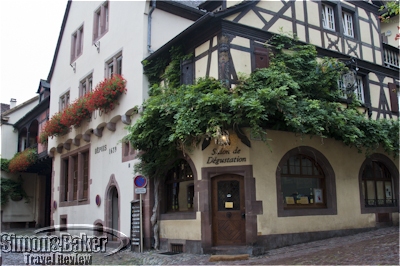
The Hugel Winery headquarters and cellars below
“A good wine,” Jean Hugel told me, “is one that you enjoy when you drink it, still appreciate when you pay for it, and can remember fondly when you wake up the next morning.” He was at the time at the head of Hugel & Fils, one of the most prestigious labels in Alsace, and a family that traces its wine making tradition back 12 generations, to 1639. I was saddened in the summer of 2009 to read his obituary in The New York Times, where he was memorialized as “a leading force in resurrecting the Alsatian wine trade.” I could only nod, and remember his passion as he introduced me to the peerless Hugel Rieslings and Gewurztraminers and most exquisite of all, the nectar-like Vendange Tardive (late harvest) wines. These prestigious wines are made in tiny quantities from overripe grapes picked well after the classic vintage, and in the best years only. These grapes have been affected by botrytis cinerea (a fungus commonly known as pourriture noble, or noble rot). Jean Hugel is credited with writing the rules for the production of Vendange Tardive, which became law in 1984. To this day, no matter where in the world I happen to be, I can never see one of the green fluted bottles with their iconic yellow Hugel label without remembering my host on that long ago afternoon.

A passing wine harvest truck shows me the way to the Hugel Winery
On the day of my visit, his nephew Etienne Hugel welcomed me to Riquewihr with the same warmth and enthusiasm. Alas, the weather was not so friendly. A cold drizzle had been falling since morning; not a propitious day for a walk to the Schoenenbourg. We headed for the cellars instead, under the meticulously preserved 16th century building of the Hugel headquarters. Along the way, we stopped by the dock where trucks were pulling in with their precious cargo of plump white grapes in plastic tubs. These were immediately brought to the press house, quality tested and selected before being tipped through a funnel designed to gravity-feed them into one of the pneumatic presses on the floor below. The free-run and first pressing juices are then directed, again by gravity only, into stainless-steel vats where they settle overnight to remove solids before the fermentation process begins (Hugel uses only these for its own label. The last pressing is always set aside and sold in bulk). The juice is then gravity-fed into giant oak casks, some over 100 years old, or into stainless steel vats for fermentation.
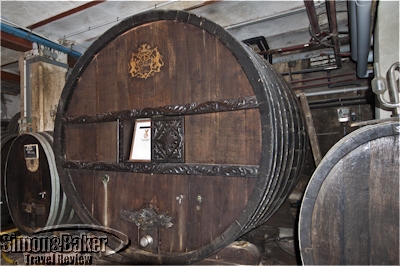
The Sainte Catherine cask dates back to 1715 and is still in use today

Wine tasting with Etienne Hugel
We continued on, farther into the cellar that reaches deep and wide under the old town. Wines mature there in rows upon impressive rows of huge casks, including the famous Sainte Catherine dating back to 1715, and still in use, before ending our tour in the tasting room. Etienne takes us on a seven-wine graduated tasting with the same verve as his uncle did so many years ago. By the time we get to the Gewurztraminer Jubilee 2008 and the divine Gewurztraminer Vendange Tardive 2005, both from the oldest plots of the Hugel estate in the heart of the Sporen grand cru area, I am ready to break all the rules of wine tasting: I sip, and I swallow. I am certain that Jean Hugel would approve
by Editor | Nov 5, 2012 | Food and Wine
Article and photos by Elena del Valle

Before dinner Chef Monica Patiño described the evening’s artisan mezcals
On my first night in Mexico City, Mexico earlier this year I had a contemporary Mexican dinner with small production mezcals and Mexican wines at the French Porfirian style home of Chef Monica Patiño. The house is exceptional, someone from Mexico City explained before we arrived. Built in 1916 in La Roma it is part of a past era and situated in one of the city’s most upscale neighborhoods.
The Body and Soul Refreshment Menu served at 8:30 p.m. began with El 19 cocktails on the first floor of the multi-level house with an inner courtyard. The refreshing and lightly sweet homemade beverages were a blend of Mano Negra, an artisanal mezcal, celery, cucumber, epazote (a fragrant Mexican herb), lemon and brown sugar, served in a short glass rimmed with salt, chili and crushed maguey worms. Delicious.

There were ten of us including the chef at the dinner table
Three hors d’oeuvres were served with the green tinted drinks. The first two were so hot (my tolerance for hot dishes is low) I only managed a single bite of each, Tostadas de Guacamole, guacamole served atop a nacho like cracker, and Tostada de Ceviche Verde, a crunchy corn cracker with citrus marinated seafood. My favorite was the Panuchos de Cochinita, a handheld appetizer of savory shredded pork without chili heat and a good match for the mild tasting cocktail.

Ricardo Garcia, chef, Naos and Jesus, his assistant, in the kitchen
Prior to dinner, some of the members of our small group watched the staff prepared the pre-appetizers. Following cocktails, we were invited to an indoor dining room with a set table, past an open kitchen where the chef and her staff prepared the meal. Before sitting at the table with us, Chef Patiño, with the assistance of Ricardo Garcia, chef, Naos (owned by Chef Patiño) and Jesus, his assistant, prepared the meal. I especially appreciated her explanations about mezcal production and the preparation of the meal during the course of the evening.

Tamalito Costeño en Caldillo de Frijol, our appetizer
For an appetizer the staff served Tamalito Costeño en Caldillo de Frijol, a tiny tamale in a black bean sauce made with corn, beans, chilies, raisins and almonds. The main course was an unusual interpretation of Pozole, a well known specialty Mexican dish. It was so unusual that several of the Mexicans in attendance were tasting the dish for the first time. A server brought each of us a bowl with Pozole Verde con Camarón, a green soup made from seeds, corn, tomato, serrano peppers, shrimp and clams. Then he brought a platter with sliced radish and sardines to us the table to add to the pozole. There was one red wine, Ensamble Colina 2008, and one white wine, Emblema 2008 sauvignon blanc, on offer with dinner. I sampled the red and found it somewhat syrupy for my taste.

Pozole Verde con Camarón, a green seafood soup
The dessert that night was my single favorite dessert during that Mexico City visit. Mixiote de Queso con Helado de Mezcal was a cheese filled filo pastry, with nougat, pumpkin seeds, atop a sauce of piloncillo (a raw sugar cane product), mezcal, and agave baked, fermented and distilled. The pastry itself was topped with mezcal ice cream which had powdered cinnamon crowning it. At the table, we were offered grated Parmesan cheese and sea salt to compliment the pastry and ice cream dish. My mouth waters at the memory. Mezcal Amores, family produced like the first one, was served with dessert.

Mixiote de Queso con Helado de Mezcal, a cheese filled filo pastry
Dinner at the chef’s home was by special arrangement. Chef Patiño has more than 34 years of experience in the kitchen. She began her career with an internship at La Hacienda de los Morales before attending L’Ecole de Cuisine de la Varenne in Paris, France. In 1978, she opened La Taberna del Leon in Valle de Bravo, Mexico. Eleven years ago, she established another La Taberna del Leon in honor of her first restaurant. Bolivar 12, serving Mexican cuisine with a Cuban influence, and Naos followed. In 2007, she became a consultant for Aeromexico. In July of this year, she taped Everyday Cooking with Mónica Patiño, a cooking segment on Utilísima, a Fox program in Argentina. Monica Patiño Marquez, +55 52 0155 55 11 05 50, monica_patino@hotmail.com




















































